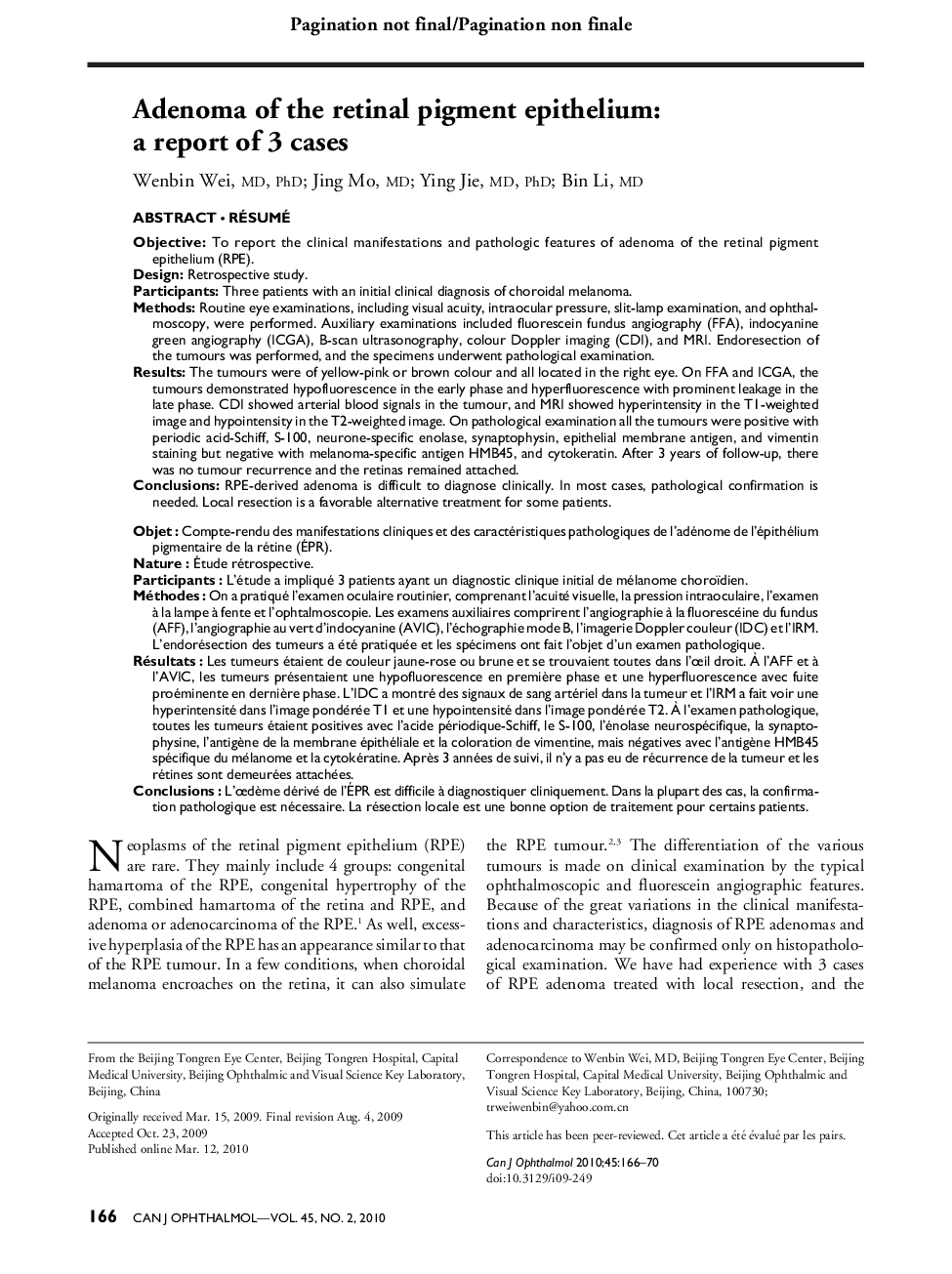| Article ID | Journal | Published Year | Pages | File Type |
|---|---|---|---|---|
| 4010364 | Canadian Journal of Ophthalmology / Journal Canadien d'Ophtalmologie | 2010 | 5 Pages |
Objective: To report the clinical manifestations and pathologic features of adenoma of the retinal pigment epithelium (RPE).Design: Retrospective study.Participants: Three patients with an initial clinical diagnosis of choroidal melanoma.Methods: Routine eye examinations, including visual acuity, intraocular pressure, slit-lamp examination, and ophthalmoscopy, were performed. Auxiliary examinations included fluorescein fundus angiography (FFA), indocyanine green angiography (ICGA), B-scan ultrasonography, colour Doppler imaging (CDI), and MRI. Endoresection of the tumours was performed, and the specimens underwent pathological examination.Results: The tumours were of yellow-pink or brown colour and all located in the right eye. On FFA and ICGA, the tumours demonstrated hypofluorescence in the early phase and hyperfluorescence with prominent leakage in the late phase. CDI showed arterial blood signals in the tumour, and MRI showed hyperintensity in the T1-weighted image and hypointensity in the T2-weighted image. On pathological examination all the tumours were positive with periodic acid-Schiff, S-100, neurone-specific enolase, synaptophysin, epithelial membrane antigen, and vimentin staining but negative with melanoma-specific antigen HMB45, and cytokeratin. After 3 years of follow-up, there was no tumour recurrence and the retinas remained attached.Conclusions: RPE-derived adenoma is difficult to diagnose clinically. In most cases, pathological confirmation is needed. Local resection is a favorable alternative treatment for some patients.
RésuméObjet: Compte-rendu des manifestations cliniques et des caracteristiques pathologiques de l’adénome de l’épithélium pigmentaire de la rétine (ÉPR).Nature: Étude rétrospective.Participants: L’étude a impliqué 3 patients ayant un diagnostic clinique initial de mélanome choroidien.Méthodes: On a pratiqué l’examen oculaire routinier, comprenant l’acuité visuelle, la pression intraoculaire, l’examen à la lampe à fente et l’ophtalmoscopie. Les examens auxiliaires comprirent l’angiographie à la fluorescéine du fundus (AFF), l’angiographie au vert d’indocyanine (AVIC), l’échographie mode B, l’imagerie Doppler couleur (IDC) et l’IRM. L’endorésection des tumeurs a été pratiquée et les spécimens ont fait l’objet d’un examen pathologique.Résultats: Les tumeurs étaient de couleur jaune-rose ou brune et se trouvaient toutes dans l’œil droit. À l’AFF et à l’AVIC, les tumeurs présentaient une hypofluorescence en première phase et une hyperfluorescence avec fuite proéminente en dernière phase. L’IDC a montré des signaux de sang artériel dans la tumeur et l’IRM a fait voir une hyperintensité dans l’image pondérée T1 et une hypointensité dans l’image pondérée T2. À l’examen pathologique, toutes les tumeurs étaient positives avec l’acide périodique-Schiff, le S-100, l’énolase neurospécifique, la synaptophysine, l’antigène de la membrane épithéliale et la coloration de vimentine, mais négatives avec l’antigène HMB45 spécifique du mélanome et la cytokératine. Après 3 années de suivi, il n’y a pas eu de récurrence de la tumeur et les reétines sont demeureées attacheées.Conclusions: L’œdème dérivé de l’ÉPR est difficile à diagnostiquer cliniquement. Dans la plupart des cas, la confirmation pathologique est neécessaire. La reésection locale est une bonne option de traitement pour certains patients.
